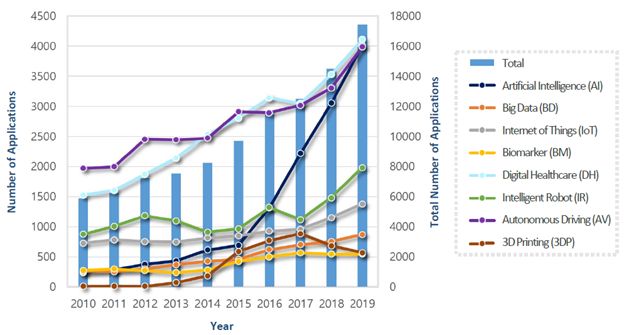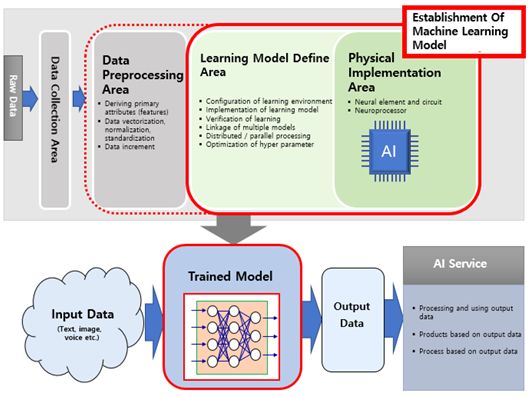- with readers working within the Oil & Gas industries
- within Law Department Performance topic(s)
- with Finance and Tax Executives
PatentNext Summary: Computer and software-implemented inventions, especially in the field of Artificial Intelligence (AI), have experienced explosive growth in both Korea and the U.S. This article compares the similarities and differences between the patent laws of the two countries and identifies considerations when drafting a software-related patent application, with a focus on AI as an example technology.
This article is co-authored by Seong Tahk AHN and Ryan N. Phelan.
Seong Tahk AHN is an attorney registered to practice in Korea and in the U.S. (Illinois), and who is admitted to the Patent Bar in Korea. He has also passed the U.S. Patent Bar Exam. Mr. AHN is a partner at Lee & Ko IP (http://www.leekoip.com/) and may be reached at ast@leekoip.com or telephone +82-2-6386-6239.
Ryan Phelan is a registered U.S. patent attorney and moderator of this Blog, PatentNext. See https://www.patentnext.com/about/.
****
The Rise of Software-Related Inventions, including AI in Korea and the U.S.
In September 2020, the Korea Intellectual Property Office (KIPO) published its Patent Statistics for the 4th Industrial Revolution-related technologies. A majority of these technologies relate specifically to software and computer arts, including technologies such as Artificial Intelligence (AI), Big Data, Internet of Things (IoT), Intelligent Robots, Autonomous Driving, and 3D Printing.
A chart from the KIPO's Patent Statistics publication is presented below.

As shown in the above chart, and as reported by the KIPO, the field of AI shows an average annual increase of 55.1% in patent applications over the past five years, which is the highest compared to other technical fields for patent filings in Korea
The U.S. has seen a similar rise in software, and in particular, AI-related patent filings. For example, in the last quarter of 2020, the United States Patent and Trademark Office (USPTO) reported that patent filings for AI related inventions more than doubled from 2002 to 2018. See Office of the Chief Economist, Inventing AI: Tracking The Diffusion Of Artificial Intelligence With Patents, IP DATA HIGHLIGHTS No. 5 (Oct. 2020).
Patent-Eligibility of Software-Inventions in Korea and in the U.S.
In Korea, generally, the patent eligibility of a software-related invention (such as an AI-related invention) is satisfied even if technical ideas are embodied in a general-purpose computer as long as the technical ideas are concretely claimed. Technical ideas tend to be assessed in terms of novelty/inventiveness rather than in terms of eligibility. The patent eligibility of software-related inventions is not strictly assessed under the patent practice in Korea.
Specifically, the KIPO Guidelines require information processing by software (such as AI) to be concretely implemented by using hardware, i.e., implementation of unique arithmetic operation or manipulation of information according to a use purpose through concrete means or methods in which software and hardware are cooperatively working. As long as unique arithmetic operation or manipulation of information according to a use purpose is concretely claimed, a general purpose computer is enough as a hardware resource to satisfy the patent eligibility. It should be noted that the hardware resource does not necessarily become a special information processing device according to a given use purpose.
Meanwhile, when an invention claims (i) economic laws or mathematical formula, (ii) arbitrary arrangements (such as design of cryptographs), (iii) mental activity or offline behavior, or (iv) mere presentation of information (such as computer program listings), the patent eligibility of the invention is denied.
In the U.S., however, AI-related inventions (and more generally software-related inventions) are routinely assessed for patent eligibility under 35 U.S.C. § 101, especially after the U.S. Supreme Court's decision in Alice Corp. v. CLS Bank International ("Alice"). Novelty and inventiveness (e.g., non-obviousness) are separate inquiries from patent eligibility, where each has its own statutory basis, 35 U.S.C. §§ 102 (novelty) and 103 (non-obviousness), respectively.
With respect to patent eligibility in the U.S., and in view of Alice, the United States Patent and Trademark Office (USPTO) considers whether a software-related invention directs to a patentable invention or to a mere "abstract idea" (which cannot be patented). In some cases, the mere recitation of the claim language, such as functional language without more, on a general-purpose computer or general-purpose processor, is insufficient to show patent eligibility in the U.S. For a more detailed overview of patent eligibility of software-related inventions in the U.S., please see How to Patent Software Inventions: Show an "Improvement" and Why including an "Algorithm" is Important for Software Patents.
As a result, and at least with respect to patent eligibility, obtaining a software-related patent in Korea typically faces fewer legal hurdles than in the U.S.
The below chart summarizes similarities and differences between Korean and U.S. law regarding Patent-Eligibility:
| Topic | Korea | U.S. |
|---|---|---|
| Recitation of a general-purpose computer or processor | Typically sufficient to demonstrate patent eligibility | Typically insufficient to demonstrate patent eligibility without showing how the invention is otherwise not "abstract" or is "significantly more" than just an abstract idea. |
| Technical ideas | Assessed in terms of novelty and inventiveness The technical ideas should be concretely claimed to implement unique arithmetic operation or manipulation of information according to a purpose of an invention. | Assessed in terms of patent eligibility pursuant to 35 U.S. Code § 101. For example, an applicant can demonstrate patent eligibility by showing that an invention provides a technological "improvement" to the underlying computer or improves another technology or technical field. See How to Patent Software Inventions: Show an "Improvement |
Patenting AI-Related Inventions in Korea and in the U.S.
1. AI-related Inventions in Korea
In January 2021, the Korean Intellectual Property Office (KIPO) newly issued a separate publication titled the "Examination Guidelines by Technology," which includes a section called "Examination Guidelines of AI-related Inventions." The KIPO's Examination Guidelines of AI-related Inventions provides detailed determination criteria and additional examples of examination cases on the patentability of artificial intelligence (AI)-related inventions.
The KIPO's Examination Guidelines of AI-related Inventions provides a diagram (as copied below) showing a basic overview of typical hardware and software components of an AI-related invention:

As shown above, KIPO's diagram illustrates that raw data (such as text, image, and/or voice data) is collected and preprocessed on a processor in order to generate a trained model. The trained model may be used in an "AI service," for a particular end-use, such as processing new data with the trained model and/or incorporation of the trained model into an end-product.
KIPO's Examination Guidelines of AI-related Inventions also provides guidance on enablement and novelty/inventiveness of AI-related inventions. For example, to demonstrate enablement (sufficiently of description), a patent application should describe a correlation between input data and output data for a trained model to implement a given AI-related invention. A sufficient disclosure includes one where a person of ordinary skill in the art would be able to estimate (or figure out) a given correlation from the common technical knowledge of AI at the time of filing of the application.
In addition, for AI-inventions that involve preprocessing raw data prior to training a model, the description should describe how to perform the function of data preprocessing specific to preparing the raw data for training of the model.
As a further example, for AI-related inventions based on reinforcement learning, the invention should include correlations among agent, environment, state, action, and reward in order for the invention to be sufficiently enabled.
With respect to issues of novelty and inventiveness, KIPO's Examination Guidelines of AI-related Inventions provides that novelty and inventiveness are determined by comparing the corresponding points and technical differences between the invention as filed and the prior art, focusing on the concrete means (learning data, data preprocessing method, learning model, loss function, etc.) of implementing an AI-related invention.
For more information, see Lee & Ko's Intellectual Property Newsletter (Winter 2021).
2. AI-related Inventions in the U.S.
In 2019, the United States Patent and Trademark Office (USPTO) provided its own guidance on the topic of patenting AI inventions. See 2019 Revised Patent Subject Matter Eligibility Guidance. For example, as part of its 2019 Revised Patent Subject Matter Eligibility Guidance (the "2019 PEG"), the USPTO provided several example patent claims and respective analyses under the two-part Alice test. See Subject Matter Eligibility Examples: Abstract Ideas.
One of these examples ("Example 39") demonstrates a patent-eligible artificial intelligence invention. In particular, Example 39 provides an example AI hypothetic invention labeled "Method for Training a Neural Network for Facial Detection" and describes an invention for addressing issues of older facial recognition methods that suffered from the inability to robustly detect human faces in images where there are shifts, distortions, and variations in scale and rotation of the face pattern in the image.
Example 39 recites claim elements for training a neural network across two stages of training set data so as to minimize false positives for facial detection. The USPTO's analysis of Example 39 informs that the above claim is patent-eligible (and not "directed to" an abstract idea under the Alice test) because the AI-specific claim elements do not recite a mere "abstract idea." See How to Patent Software Inventions: Show an "Improvement". In particular, while some of the claim elements may be based on mathematical concepts, such concepts are not recited in the claim. Further, the claim does not recite a mental process because the steps are not practically performed in the human mind. Finally, the claim does not recite any method of organizing human activity, such as a fundamental economic concept or meaningful interactions between people. Because the claims do not fall into one of these three categories, then, according to the USPTO, the claim is patent-eligible.
As a further example, the Patent Trial and Appeal Board (PTAB) more recently applied the 2019 PEG (as revised) in an ex parte appeal involving an artificial intelligence invention. See ex parte Hannun (formerly Ex parte Linden), 2018-003323 (April 1, 2019) (designated by the PTAB as an "Informative" decision). In Hannun, the patent-at-issue related to "systems and methods for improving the transcription of speech into text." The claims included several AI-related elements, including "a set of training samples used to train a trained neural network model" as used to interpret a string of characters for speech translation.
Applying the two-part Alice test, the Examiner had rejected the claims finding them patent-ineligible as merely abstract ideas (i.e., mathematical concepts and certain methods of organizing human activity without significantly more.)
The PTAB disagreed, instead, finding the patent-at-issue in Hannun patent-eligible. Importantly, the PTAB noted the importance of the specification describing how the claimed invention provides an improvement to the technical field of speech recognition, with the PTAB specifically noting that "the Specification describes that using DeepSpeech learning, i.e., a trained neural network, along with a language model 'achieves higher performance than traditional methods on hard speech recognition tasks while also being much simpler.'" For additional information, see How to Patent an Artificial Intelligence (AI) Invention: Guidance from the U.S. Patent Office (USPTO).
In the U.S., AI-Inventions are treated under the same standards for novelty (35 U.S.C. § 102) and inventiveness (35 U.S.C. § 103) as for other inventions.
With respect to the sufficiency of disclosure, while the USPTO has not provided specific guidance on AI-related inventions, the USPTO did publish, in 2019, general guidance on computer-related inventions. See Examining Computer-Implemented Functional Claim Limitations for Compliance With 35 U.S.C. 112 (the "U.S. Section 112 Guidance"). In the U.S., section 112 deals with issues of written description, enablement, and definiteness.
For example, with respect to a sufficient written description, the U.S. Section 112 Guidance informs that "[f]or computer-implemented functional claims, the determination of the sufficiency of the disclosure will require an inquiry into the sufficiency of both the disclosed hardware and the disclosed software, due to the interrelationship and interdependence of computer hardware and software." A sufficient written description should disclose "the computer and the algorithm(s) that achieve the claimed function in sufficient detail that one of ordinary skill in the art can reasonably conclude that the inventor possessed the claimed subject matter at the time of filing." And, an applicant for a patent may "express that algorithm in any understandable terms including as a mathematical formula, in prose, or as a flow chart, or in any other manner that provides sufficient structure."
In summary, the U.S. and Korea each provide guidance with respect to computer-related and software-related inventions. At least for the time being, however, the KIPO provides more specific guidance on AI-related inventions. Nonetheless, the USPTO does provide similar guidance in that an algorithm, sufficient to inform those of ordinary skill in the art, should be provided for computer-implemented for computer-related inventions (which would presumably apply to AI-related invention as well given that AI-inventions are squarely within the computer-implemented invention realm).
The content of this article is intended to provide a general guide to the subject matter. Specialist advice should be sought about your specific circumstances.


